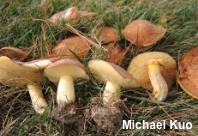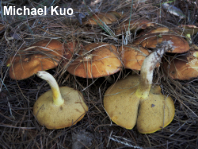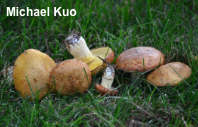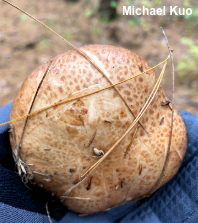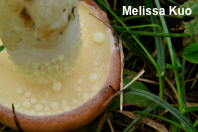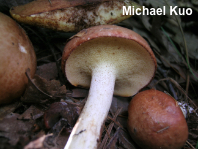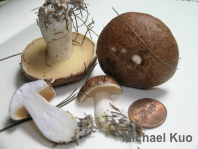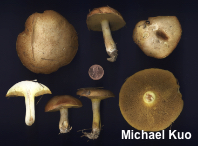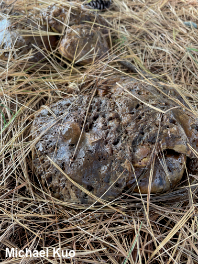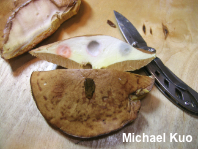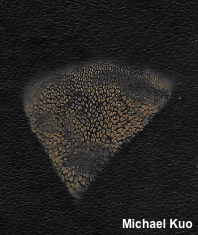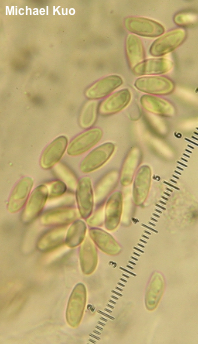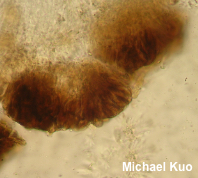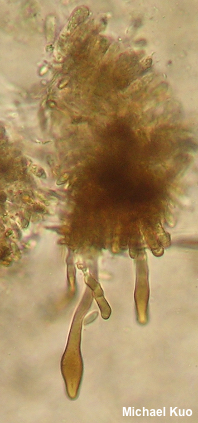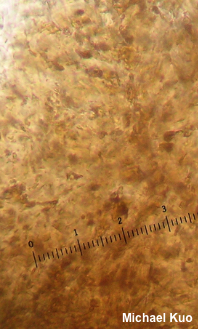| Major Groups > Boletes > Suillus > Suillus weaverae |

|
Suillus weaverae [ Basidiomycota > Boletales > Suillaceae > Suillus . . . ] by Michael Kuo This species is strictly associated with eastern white pine, and is the eastern North American "Suillus granulatus" found in virtually every American field guide (including those written by me). Research by Nhu Nguyen and collaborators (2016) supports the idea that the true Suillus granulatus is a European associate of hard pines (species of Pinus with needles bundled in twos and/or threes), possibly imported in some North American locations along with their pine hosts—while the species North Americans have been calling "Suillus granulatus" is associated with a soft (5-needled) pine and is actually not even particularly closely related to Suillus granulatus, despite its close resemblance. Suillus weaverae features a reddish- to orangish-brown, sticky cap that often develops a patchwork pigment pattern, along with small, contrasting glandular dots on the stem surface. There is no ring on the stem, nor any partial veil remnants on the cap, and the dull yellow pore surface features smallish pores that are not strongly boletinoid. Since this description applies equally to Suillus granulatus, the association with eastern white pine is an essential identification character. In fact the appearance of Suillus weaverae changes pretty drastically over the course of development. Young specimens can have dark reddish brown caps, a white pore surface, white flesh, and inconspicuous glandular dots—while old specimens have tan caps, yellow pores and flesh, and fairly conspicuous glandular dots. Under the microscope, the pileipellis elements of young specimens can be hard to view due to globules of pigment, while in older specimens these globules have disappeared. Very old specimens of Suillus weaverae are mushy and brown, and may well get the award for Most Disgustingly Splatty Boletes Ever. "Suillus lactifluus," as it has been interpreted in North America, is a synonym for Suillus weaverae (in Europe it is a synonym for Suillus granulatus). The name was formerly applied to a form possessing a stem that is more yellow in youth, glandular dots that do not darken as much, and a young pore surface frequently beaded with milky droplets; these characters, however, fall within the range of Suillus weaverae's (and Suillus granulatus's) variability—and Nguyen and collaborators (2016) found no DNA support for separating specimens identified as Suillus lactifluus. For those who care about such things, Suillus weaverae was initially described by Smith & Shaffer (1965) based on a collection and accompanying notes sent to them from "Mrs. Paul H. Weaver, of Faribault, Minnesota." Based on the color of the spore print they placed the collection in the now-synonymized-with-Suillus genus "Fuscoboletinus," and also misinterpreted a white filmy coating on the pore surfaces and sheathing the stems as a partial veil—when in fact it was a Hypomyces infection beginning to spread across the Suillus. Thus the new "species" was really just a collection of what was then called Suillus granulatus in North America, and the type collection, when sequenced by Nguyen and collaborators, turned out to be the same species as other granulatus-like, white-pine-associated collections from eastern North America. Ironically, then, Suillus weaverae turns out to be the first official description of the species, and the name must be applied even though the original authors of the species were sure they were looking at something completely different. Description: Ecology: Mycorrhizal with eastern white pine; growing alone or, more often, gregariously; summer (often among the first species of Suillus to appear) through early winter or, in warm climates, over winter; originally described from Minnesota (but see discussion above); widely distributed throughout the natural range of eastern white pine, as well as areas where the tree is widely planted in urban locations and in woodland plantations. The illustrated and described collections are from Illinois. Cap: 3–20 cm across; convex becoming broadly convex or nearly flat; sticky or slimy when fresh; bald; orange-brown to reddish brown when young, often with the pigment breaking up into mosaic-like patches; becoming dull orangish brown, yellow-brown, pale brown, or tan with maturity and eventually, in decay, dark brown; margin when young sometimes soft, whitish, and overhanging by a few millimeters. Pore Surface: Often beginning to run down the stem; whitish at first, but soon yellowish and eventually dull brownish yellow; sometimes dotted with droplets of cloudy liquid when young; not bruising, or sometimes bruising and spotting brownish; pores about 1 mm wide at maturity; not strongly boletinoid but sometimes weakly so in age; tubes up to 1 cm deep. Stem: 4–8 cm long; 1–2 cm thick; equal or with a tapering base; with tiny, yellow to pinkish or brownish glandular dots on the upper half or overall; without a ring; white, developing bright yellow shades near the apex or overall; sometimes bruising slowly brown where handled; basal mycelium white. Flesh: White at first, but soon pale yellow; not changing when sliced. Odor and Taste: Odor a little fragrant, or not distinctive; taste slightly sour, or not distinctive. Chemical Reactions: Ammonia negative on dark young caps, and negative on older, less pigmented caps; pink on flesh; dull salmon pink on pore surface. KOH flashing dark green, then resolving to greenish black on young caps, but merely dark gray on older caps; dark gray to purplish or bluish on flesh; dull salmon pink on pore surface. Iron salts gray on young caps, but negative on older caps; bluish to purplish on flesh; olive to green on pore surface. Spore Print: Cinnamon brown to brown. Microscopic Features: Spores 6–10 x 2–3 µm; boletoid-fusiform; smooth; hyaline to yellowish in KOH. Basidia 22–28 x 4–5 µm; subclavate; 4-sterigmate. Hymenial cystidia in bundles; 30–90 x 4–11 µm when clearly defined; cylindric with subclavate apices, or fusiform to lageniform; smooth; thin-walled; brown in KOH; often gelatinizing and poorly defined individually. Pileipellis an ixocutis; elements in young caps often obscured by extensive gelatinization and dark yellow-brown pigment globules; elements in older caps 2.5–10 wide, smooth or appearing encrusted by tiny pigment globules, brownish to brown in KOH. REFERENCES: (A. H. Smith & R. L. Shaffer, 1965) H. Engel & W. Klofac, 1996. (Coker & Beers, 1943; Singer, 1945; Smith & Thiers, 1964; Snell & Dick, 1970; Smith & Thiers, 1971; Grund & Harrison, 1976; Smith, Smith & Weber, 1981; Arora, 1986; States, 1990; Phillips, 1991/2005; Lincoff, 1992; Both, 1993; Horn, Kay & Abel, 1993; Evenson, 1997; Barron, 1999; Bessette, Roody & Bessette, 2000; Roody, 2003; McNeil, 2006; Miller & Miller, 2006; Kuo, 2007; Bruns et al., 2010; Kuo & Methven, 2014; Bessette, Roody & Bessette, 2016; Nguyen et al., 2016; Baroni, 2017; Elliott & Stephenson, 2018; Sturgeon, 2018; McKnight et al., 2021.) Herb. Kuo 12069402, 09199609, 09190304, 07270403, 08191405, 09231501, 09231502, 10071807. Herb. EIU 016. This site contains no information about the edibility or toxicity of mushrooms. |
© MushroomExpert.Com |
|
Cite this page as: Kuo, M. (2022, February). Suillus weaverae. Retrieved from the MushroomExpert.Com Web site: http://www.mushroomexpert.com/suillus_weaverae.html |
